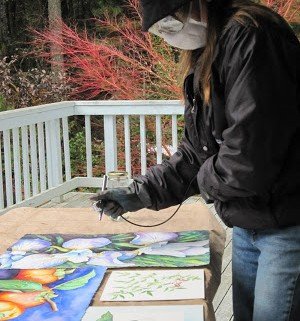TIPS & TRICKS for using ACRYLIC MEDIUMS
Coating with acrylic is an experimental process. Be sure to test your results with art that is not precious (using comparable paper or board and paint) before risking your best work.
Photograph your work before you top coat to get the best image. It’s harder to get a good photograph through the acrylic layers.
Allow artwork to completely dry before adding acrylic as moisture trapped within will not escape and could bubble or remain opaque. Allow each under layer to dry before adding more acrylic.
Create a dust-free, no-pet zone for working with acrylic. Covering your work surface with plastic will help keep both art and surface clean.
Apply gels with an inexpensive synthetic paint brush or an old credit card. Do not use good watercolor brushes (it will ruin them) or crumbly foam brushes to apply.
Acrylic mediums clean up with water and a little gentle soap. Keep a jar of water to dip your brush in or wrap the brush in plastic if you cannot clean it right away. Keep lids on mediums sealed when not in use Removing excess gunk from lids will make them open easier.
Always spray the MSA archival varnish outdoors. Using a mask & goggles will protect your lungs and eyes. It is also available in liquid form for airbrush application, diluting with mineral spirits. In this form it is less expensive and creates fewer particulates in the air to breathe.
Make sure your signature is in permanent ink or has been varnished. Spray several layers of varnish to seal your paint well and it will not lift when brushing on the Top Coat. Because paper is porous, it might take up to seven coats — especially with thick or dark pigments. Varnishing before mounting will help protect the art during the mounting process.
Be aware of stretching and shrinkage of paper when mounting with acrylic. If the paper has not fully relaxed before applying, it can bubble against a rigid surface. On the other hand, when fully stretched, a great deal of surface tension is created as it dries, which in a larger piece can buckle a backing that is not entirely rigid.
While mounting, make sure you have art lined up straight with the backng. Tack in position with tape. Use weight — old garden encyclopedias work — to hold paper securely to the panel as it dries.
Use sheets of acrylic or wax paper to keep art from sticking to other surfaces such as books used for weight.
Check for buckling before the acrylic dries completely and you may still be able to smooth surface wrinkles. Cover with a protective acrylic sheet and rub with your hands, lift and replace a corner if necessary.
Always reserve your matting agent for the last coat. While it’s OK to build up several layers of gloss, multiple layers of matt or semi-gloss will begin to obscure the art with a frosted look. A final layer of semi-gloss on the top is enough to knock back unwanted shine.
Also see the posts WATERCOLOR ON CRADLED PANEL
and ACRYLIC FINISHES FOR WATERCOLOR
© René Eisenbart / www.rene-art.com





Leave a Reply
Want to join the discussion?Feel free to contribute!